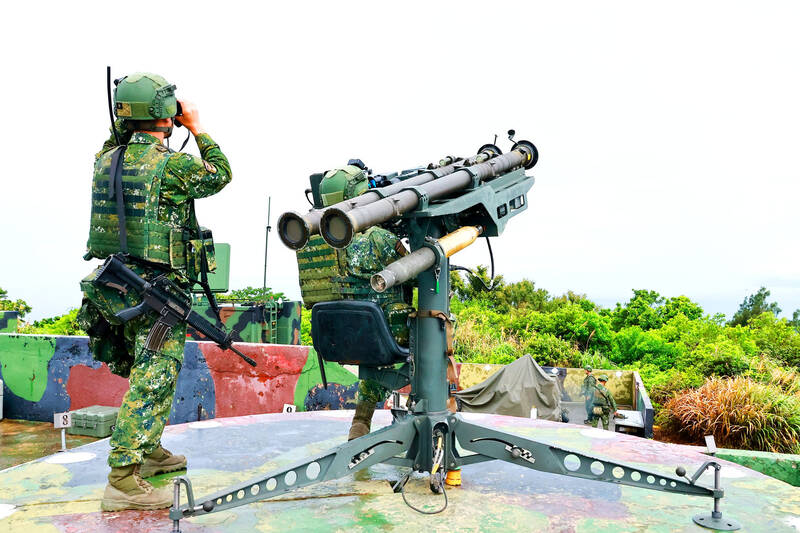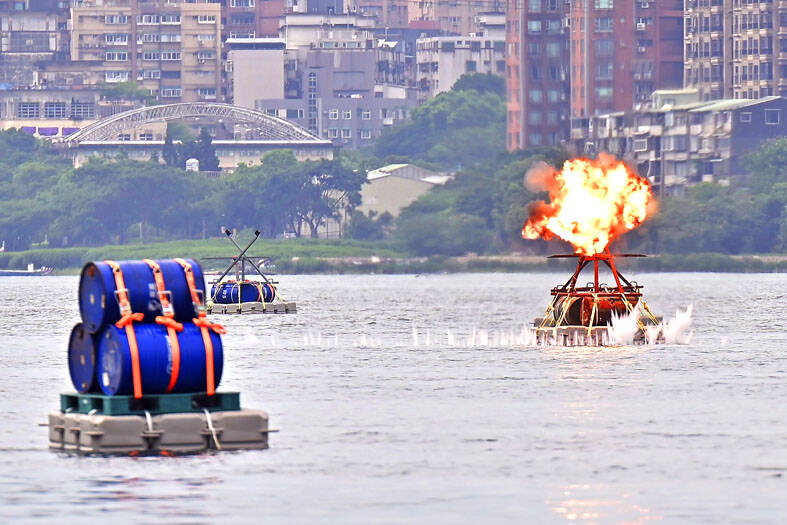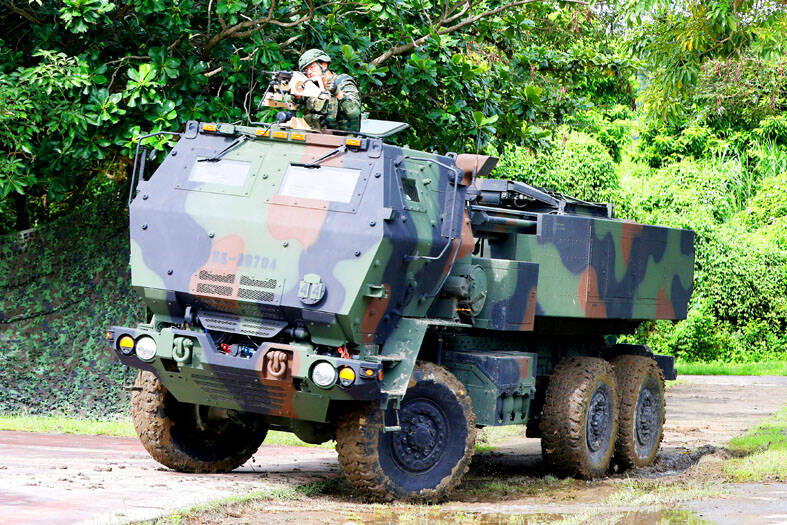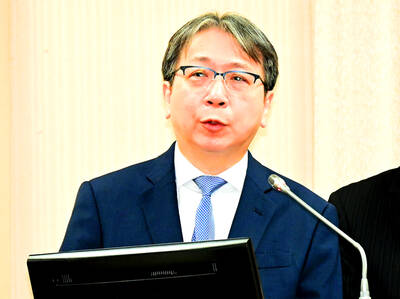Army combat engineers yesterday deployed anti-landing obstacles and remotely detonated explosives during a simulated defense of the Tamsui River as part of this year’s Han Kuang military exercise.
Yesterday was the fourth day of the exercise, during which the military transitioned from countering “gray zone” incursions to full-scale warfare, according to the military’s drill schedule.
The unprecedented use of live explosives in the access denial drills reflected the 41st Han Kuang exercise’s emphasis on realism and operationally relevant warfighting skills, Association of Strategic Foresight analyst Chieh Chung (揭仲) said from the sidelines of the event.

Photo courtesy of ROC Army Matsu Defense Command
This year’s iteration of the annual exercise — the largest yet in the drill’s history — envisions the Taiwanese armed forces deploying for defensive operations following intelligence assessments showing a significant military build-up on China’s southeastern coastline, he said.
The army built four defensive belts along the river to counter high-speed surface vessels and uncrewed underwater vehicles, Chieh said.
During the drills, Tamsui, a causeway leading to Taipei, was a key defensive zone for the army as it sought to prevent a Chinese People’s Liberation Army (PLA) advance, he said.

Photo: Tu Chien-jung, Taipei Times
Should the PLA gain control of the riverbanks and Tamsui itself, the Chinese troops would be able to build a salient point to the nation’s strategic center of gravity, and would be able to link up with a potential main landing force in New Taipei City’s Bali District (八里), he said.
The use of live explosives in the exercise would help Taiwanese forces assigned to river defense ascertain the effectiveness of their operational plans, Chieh said.
This included the appropriate number, width and depth of defensive lines, the density of obstacles and the correct amount of explosives needed to destroy or disable enemy vessels, he added.

Photo: Ann Wang, Reuters
The Tamsui River holds key strategic value for Taiwan’s defense, as the mouth of the river is less than an hour’s drive to the Presidential Office Building in Taipei, a defense official said on condition of anonymity.
The PLA is cognizant of the strategic potential of amphibious operations and has heavily invested in hovercraft and other capabilities to enable rapid and powerful assaults on beachheads and riverfronts, they said.
Underscoring the importance of controlling Tamsui, the 1st Combined Arms Battalion of the Army Guandu Area Command is permanently assigned to defend the area at all hours, they said.
In the event of war, Taiwanese ground forces would stage a defense, utilizing artillery, mines and obstacles to prevent PLA landing forces from moving into Taiwan proper via its major rivers, the Ministry of National Defense said in a report to the Legislative Yuan.
The defense would incorporate detonation cords and gasoline barrels to bar the way of Chinese watercraft while subjecting them to direct and indirect fire from strongpoints alongside the river bank, it said.
Separately, a delegation of US military advisers headed by former US Indo-Pacific Command commander and retired army general Charles Flynn visited the Tamsui area to observe the drills, an official said on condition of anonymity.
The advisers gave “specific and constructive” recommendations, including suggesting that Taiwanese forces adjust their priorities when reacting to changing operational situations, and rectifying weaknesses in their defense, they said.
In May last year, retired US Navy rear admiral Mark Montgomery told the US House Select Committee on China that the Pentagon was too slow in helping Taiwanese troops prepare for a potential conflict with China.
US military assistance is indispensable for molding a Taiwanese military truly capable of defending itself against aggression, he said at the time, adding that providing the nation with Harpoon missiles would make no difference if the troops do not know how to operate the weapons.
Flynn at the same hearing said that China plans to make Taiwan submit without fighting a war, but the US could no longer afford to ignore the threat posed by the PLA’s air, sea and land capabilities.

The US government has signed defense cooperation agreements with Japan and the Philippines to boost the deterrence capabilities of countries in the first island chain, a report by the National Security Bureau (NSB) showed. The main countries on the first island chain include the two nations and Taiwan. The bureau is to present the report at a meeting of the legislature’s Foreign Affairs and National Defense Committee tomorrow. The US military has deployed Typhon missile systems to Japan’s Yamaguchi Prefecture and Zambales province in the Philippines during their joint military exercises. It has also installed NMESIS anti-ship systems in Japan’s Okinawa

‘WIN-WIN’: The Philippines, and central and eastern European countries are important potential drone cooperation partners, Minister of Foreign Affairs Lin Chia-lung said Minister of Foreign Affairs Lin Chia-lung (林佳龍) in an interview published yesterday confirmed that there are joint ventures between Taiwan and Poland in the drone industry. Lin made the remark in an exclusive interview with the Chinese-language Liberty Times (the Taipei Times’ sister paper). The government-backed Taiwan Excellence Drone International Business Opportunities Alliance and the Polish Chamber of Unmanned Systems on Wednesday last week signed a memorandum of understanding in Poland to develop a “non-China” supply chain for drones and work together on key technologies. Asked if Taiwan prioritized Poland among central and eastern European countries in drone collaboration, Lin

ON ALERT: Taiwan’s partners would issue warnings if China attempted to use Interpol to target Taiwanese, and the global body has mechanisms to prevent it, an official said China has stationed two to four people specializing in Taiwan affairs at its embassies in several democratic countries to monitor and harass Taiwanese, actions that the host nations would not tolerate, National Security Bureau (NSB) Director-General Tsai Ming-yen (蔡明彥) said yesterday. Tsai made the comments at a meeting of the legislature’s Foreign Affairs and National Defense Committee, which asked him and Minister of National Defense Wellington Koo (顧立雄) to report on potential conflicts in the Taiwan Strait and military preparedness. Democratic Progressive Party (DPP) Legislator Michelle Lin (林楚茵) expressed concern that Beijing has posted personnel from China’s Taiwan Affairs Office to its

BACK TO WORK? Prosecutors said they are considering filing an appeal, while the Hsinchu City Government said it has applied for Ann Kao’s reinstatement as mayor The High Court yesterday found suspended Hsinchu mayor Ann Kao (高虹安) not guilty of embezzling assistant fees, reducing her sentence to six months in prison commutable to a fine from seven years and four months. The verdict acquitted Kao of the corruption charge, but found her guilty of causing a public official to commit document forgery. The High Prosecutors’ Office said it is reviewing the ruling and considering whether to file an appeal. The Taipei District Court in July last year sentenced Kao to seven years and four months in prison, along with a four-year deprivation of civil rights, for contravening the Anti-Corruption